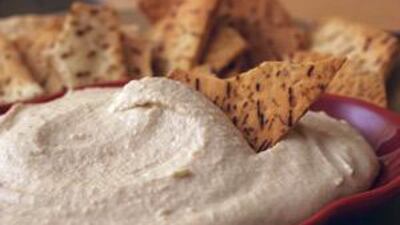The humble chickpea is older than farming in central and northern Europe, irrigation and agriculture in Ancient Egypt. Hardly an outmoded relic, the chickpea - also known as the garbanzo bean Indian pea, Bengal gram and shimbra, among other names -is more loved today than ever before. Once cooked, chickpeas can be curried or stewed, made into falafel, or ground into flour and baked into a delicious "pizza" called socca in its hometown of Nice or farinata in Liguria. In the Philippiness, chickpeas in syrup are incorporated into desserts. Because of their high protein content, they are a staple to vegetarians everywhere. In the Levant, raw chickpeas are often snacked upon. However, the luckiest chickpeas of all, in my opinion, are made into hummus.
A meal of bread and hummus is a complete protein. If it seems silly to offer a recipe for a dish so rudimentary and ubiquitous, then you may already have one with which you're satisfied. But if, like me, you have been searching for the ultimate hummus, dip in to this one. In one of my first columns, I wrote about the regional war being waged for the rights to falafel, an issue that I make no secret of finding ridiculous. The exact origins of hummus remain unknown, however, in his etymological column On Language, the writer Philologos of The Jewish Daily Forward muses: "Although both hummus and falalafel are originally Arab foods, they have been popularised in America to a considerable extent by Israelis, who are avid consumers of both, with the result that the question of whether they are to be considered Arab or Israeli dishes has become a small part of the Middle East conflict. About hummus there is no room for argument: it is Arab through and through."
The hummus recipe that I use and love is one I learnt from favourite cookbook: A Mediterranean Feast: The Story of the Birth of the Celebrated Cuisines of the Mediterranean from the Merchants of Venice to the Barbary Corsairs, with More than 500 Recipes by Clifford A Wright. With this book, Wright gives us a little taste of something we could all use now and then: an honorary Lebanese grandmother.
Though time-consuming and labour-intensive, his hummus recipe is not difficult and the results are worth it. If it were easier, or if I were willing to compromise on taste by taking shortcuts, I'd make this hummus every other day. But that would also make it much less special. For this recipe, you will need three cups of dried chickpeas (it pays to use dried chickpeas, but canned ones are not the end of the world), one cup of olive oil, ½ cup of tahini (sesame paste), ½ cup of fresh-squeezed lemon juice (emphasis on fresh), eight cloves of garlic mashed to a paste in a mortar and pestle, cumin and sumac. You will also need a food processor.
Be sure to buy the chickpeas from a reputable source with high turnover - old chickpeas will never finish cooking. Rinse the chickpeas vigorously and discard any that are dark or shrunk. Soak in a bowl with cold water to cover by several inches. Add one tablespoon of baking soda, which will soften the peas, helping them to achieve a satiny texture, and refrigerate overnight or for six to eight hours.
When you are ready to cook the chickpeas, give them another rinse and put them in a large pot with several inches of water to cover. Cover and bring to a boil over a high heat, then remove the lid and reduce to heat to medium. At this point, you may be tempted to add salt: don't. It will toughen the chickpeas. Some people like to use a pressure cooker, but I prefer not to so that I can keep a close eye on the chickpeas, using a slotted spoon to skim off foam and impurities as they gather on the surface. Once solid foam ceases to rise to the top, you can cover the pot, reduce heat to low and let the chickpeas cook for one and a half to two hours, or until they become tender. They are ready when they are no longer crumbly, or when you can mash one to a smooth paste against the roof of your mouth using only your tongue.
Drain the cooked chickpeas, reserving one cup of the strained cooking liquid, which may come in handy later. Now comes the most tedious part: removing all the skins. Many will have already floated to the surface, but others will have to be rubbed off by hand. Don't worry about keeping the chickpeas intact as they will all be puréed soon enough. Rinse again and again, draining away the skins into a colander or bowl.
Once you have completed this step, you will have the essence of chickpea as your raw material: buttery, nutty and sweet. Tumble the chickpeas into the bowl of a food processor and purée until smooth, adding the tahini, lemon juice, garlic and ¾ cup of the olive oil. Season to taste with salt and pepper and add a dash of cumin to taste. You will need more salt than you think is prudent. If the mixture seems too thick or pasty (it should not be thick enough to stick to a spoon), gradually thin it with the reserved chickpea cooking water until you reach the desired consistency.
Pour the hummus onto a platter and garnish with the remaining olive oil and dashes of sumac, chopped parsley, toasted pine nuts, pitted olives, or all of the above. Serve with warm Arabic bread and crudités.

